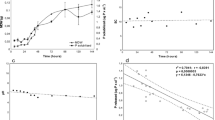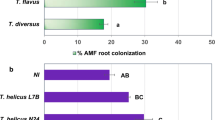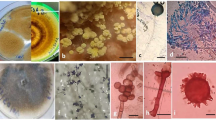Abstract
Fenpropimorph and fenhexamid are sterol biosynthesis inhibitor (SBI) molecules widely used to control diseases in agriculture. Both molecules, at increasing concentrations, have been shown to impact on the non-target arbuscular mycorrhizal (AM) fungi. Root colonization, spore production and mycelium architecture, including the branched absorbing structures which are thought to be involved in phosphorus (P) uptake, were affected. In the present study, we investigated the capacity of Glomus sp. MUCL 43204 to take up, transfer and translocate labelled P to Medicago truncatula in the presence of these SBI molecules. We used a strict in vitro cultivation system associating an autotrophic plant of M. truncatula with the AM fungus. In addition, the effects of both SBI molecules on the proportion of hyphae with alkaline phosphatases (ALP), succinate dehydrogenase (SDH) activity and on the expression of the mycorrhiza-specific plant phosphate transporter MtPT4 gene were examined. We demonstrated that the two SBI molecules impacted the AM fungus. This was particularly evidenced for fenpropimorph. A decrease in P transport and ALP and SDH activities associated with the extraradical mycelium and MtPT4 expression level was noted. These three factors were closely related to the development of the AM fungus, suggesting a direct impact not only on the AM fungal growth but also on the physiology and metabolic activities of the AM fungus. These results further emphasized the interest on the autotrophic in vitro culture system as an alternative to pot experiments to investigate the mechanisms behind the impact of disease control molecules on the non-target AM fungal symbionts.


Similar content being viewed by others
References
Aono T, Maldonado-Mendoza IE, Dewbre GR, Harrison MJ, Masanori S (2004) Expression of alkaline phosphatase genes in arbuscular mycorrhizas. New Phytol 162:525–534
Bago B (2000) Putative sites for nutrient uptake in arbuscular mycorrhizal fungi. Plant Soil 226:263–274
Becker DA, Grenberg RR, Stone SF (1992) The use of high accuracy NAA for the certification of NIST botanical standard reference materials. J Radioanal Nucl Chem 160:41–53
Braskerud BC, Haarstad K (2003) Screening the retention of thirteen pesticides in a small constructed wetland. Water Sci Technol 48:267–274
Campagnac E, Fontaine J, Lounes-Hadj Sahraoui A, Laruelle F, Durand R, Grandmougin-Ferjani (2008) Differential effects of fenpropimorph and fenhexamid, two sterol biosynthesis inhibitor fungicides, on arbuscular mycorrhizal development and sterol metabolism in carrot roots. Phytochemistry 69:2912–2919
Campagnac E, Fontaine J, Lounes-Hadj Sahraoui A, Laruelle F, Durand R, Grandmougin-Ferjani A (2009) Fenpropimorph slows down the sterol pathway and the development of the arbuscular mycorrhizal fungus Glomus intraradices. Mycorrhiza 19:365–374
Campagnac E, Lounes-Hadj Sahraoui A, Debiane D, Fontaine J, Laruelle F, Garcon G, Verdin A, Durand R, Shirali P, Grandmougin-Ferjani A (2010) Arbuscular mycorrhiza partially protect chicory roots against oxidative stress induced by two fungicides, fenpropimorph and fenhexamid. Mycorrhiza 20:167–178
Declerck S, Strullu DG, Plenchette C (1998) Monoxenic culture of the intraradical forms of Glomus sp. isolated from a tropical ecosystem: a proposed methodology for germoplasm collection. Mycologia 90:579–585
Declerck S, D’Or D, Cranenbrouck S, Le Boulengé E (2001) Modelling the sporulation dynamics of arbuscular mycorrhizal fungi in monoxenic culture. Mycorrhiza 11:225–230
Doner LW, Becard G (1991) Solubilization of gellan gels by chelation of cations. Biotechnol Tech 5:25–28
Dupré de Boulois H, Delvaux B, Declerck S (2005) Effects of arbuscular mycorrhizal fungi on the root uptake and translocation of radiocesium. Environ Pollut 134:515–524
Dupré de Boulois H, Voets L, Delvaux B, Jackobsen I, Declerck S (2006) Transport of radiocesium by arbuscular mycorrhizal fungi to Medicago truncatula under in vitro conditions. Environ Microbiol 8:1926–1934
Ezawa T, Smith SE, Smith FA (2001) Differentiation of polyphosphate metabolism between the extra- and intraradical hyphae of arbuscular mycorrhizal fungi. New Phytol 149:555–563
Ezawa T, Cavagnaro TR, Smith SE, Smith FA, Ohtomo R (2003) Rapid accumulation of polyphosphate in extraradical hyphae of an arbuscular mycorrhizal fungus as revealed by histochemistry and a polyphosphate kinase/luciferase system. New Phytol 161:387–392
González-Guerrero M, Oger E, Benabdellah K, Azcón-Aguilar C, Lanfranco L, Ferrol N (2010) Characterization of a Cu, Zn superoxide dismutase gene in the arbuscular mycorrhizal fungus Glomus intraradices. Curr Genet 56:265–274
Harrison MJ, van Buuren M (1995) Phosphate transporter from the mycorrhizal fungus Glomus versiforme. Nature 378:626–629
Harrison MJ, Dewbre GR, Liu JY (2002) Phosphate transporter from Medicago truncatula involved in the acquisition of phosphate released by arbuscular mycorrhizal fungi. Plant Cell 14:413–2429
Isayenkov S, Fester T, Hause B (2004) Rapid determination of fungal colonisation and arbuscule formation in roots of Medicago truncatula using real-time (RT) PCR. J Plant Physiol 161:1379–1383
Javot H, Pumplin N, Harrison MJ (2007a) Phosphate in the arbuscular mycorrhizal symbiosis: transport properties and regulatory roles. Plant Cell Environ 30:310–322
Javot H, Penmetsa RV, Terzaghi N, Cook DR, Harrison MJ (2007b) A Medicago truncatula phosphate transporter indispensable for the arbuscular mycorrhizal symbiosis. Proc Natl Acad Sci USA 104:1720–1725
Kah M, Brown CS (2007) Prediction of the adsorption of ionisable pesticides in soils. J Agr Food Chem 55:2312–2322
Kjoller R, Rosendahl S (2000) Effects of fungicides on arbuscular mycorrhizal fungi: differential responses in alkaline phosphatase activity of external and internal hyphae. Biol Fertil Soils 31:361–365
Martin SW, Konopka JB (2004) Lipid raft polarization contributes to hyphal growth in Candida albicans. Eukaryotic Cell 3:675–684
Marx D (2004) The root of plant–microbes collaborations. Science 304:234–236
McGonigle TP, Miller MH, Evans DG, Fairchild GL, Swan JA (1990) A new method which gives an objective measure of colonization of roots by vesicular–arbuscular mycorrhizal fungi. New Phytol 115:495–501
Nielsen JS, Joner EJ, Declerck S, Olsson S, Jakobsen I (2002) Phospho-imaging as a tool for visualization and noninvasive measurement of P transport dynamics in arbuscular mycorrhizas. New Phytol 154:809–820
Oger E, Ghignone S, Campagnac E, Fontaine J, Grandmougin-Ferjani A, Lanfranco L (2009) Functional characterization of a C-4 sterol methyl oxidase from the endomycorrhizal fungus Glomus intraradices. Fungal Genet Biol 46:486–495
Parniske M (2008) Arbuscular mycorrhiza: the mother of plant root endosymbioses. Nat Rev Microbiol 6:763–775
Rasmussen R (2001) Quantification on the LightCycler. In: Meuer S, Wittner C, Nakagawara K (eds) Rapid cycle real-time PCR methods and applications. Springer, Heidelberg, pp 21–34
Ririe KM, Rasmussen RP, Wittwer CT (1997) Product differentiation by analysis of DNA melting curves during the polymerase chain reaction. Anal Biochem 245(154):160
Roy C, Gaillardon P, Montfort F (2009) The effect of soil moisture content on the sorption of five sterol biosynthesis inhibiting fungicides as a function of their physicochemical properties. Pest Manage Sci 56:795–803
Saha D, Purkayastha G, Saha A (2008) Degradation of mancozeb and thiophanate-methyl by bacteria isolated from tea-garden soil. Environ Ecol 26:2231–2235
Sarkar S, Seenivasan S, Premkumar R (2009) Biodegradation of propiconazole by Pseudomonas putida isolated from tea rhizosphere. Plant Soil Environ 55:196–201
Schweiger PF, Jakobsen I (1998) Dose–response relationships between four pesticides and phosphorus uptake by hyphae of arbuscular mycorrhizas. Soil Biol Biochem 30:1415–1422
Smith S, Dickson S (1997) Vital staining: nitroblue tetrazolium. In: VA mycorrhizas: basic research and techniques. CRCS and Land Management, Glen Osmond, p 13
Smith SE, Gianinazzi-Pearson V (1990) Phosphate uptake and arbuscular activity in mycorrhizal Allium cepa L. Effects of photon irradiance and phosphate nutrition. Aust J Plant Physiol 17:177–188
Smith SE, Read DJ (2008) Mycorrhizal symbiosis. Academic, London
Stockinger H, Walker C, Schüßler A (2009) Glomus intraradices DAOM197198, a model fungus in arbuscular mycorrhiza research, is not Glomus intraradices. New Phytol 183:1176–1187
Sukarno N, Smith SE, Scott ES (2006) The effect of fungicides on vesicular–arbuscular mycorrhizal symbiosis. New Phytol 125:139–147
Van Aarle IM, Olsson PA, Söderström B (2001) Microscopic detection of phosphatase activity of saprophytic and arbuscular mycorrhizal fungi using a fluorogenic substrate. Mycologia 93:17–24
Van Aarle IM, Rouhier H, Saito M (2002) Phosphatase activities of arbuscular mycorrhizal intraradical and extraradical mycelium, and their relation to phosphorus availability. Mycol Res 106:1224–1229
Van der Heijden MGA, Streitwolf-Engel R, Riedl R, Siegrist S, Neudecker A, Ineichen K, Boller T, Wiemken A, Sanders IR (2006) The mycorrhizal contribution to plant productivity, plant nutrition and soil structure in experimental grassland. New Phytol 172:739–752
Voets L, de la Providencia IE, Fernandez K, IJdo M, Cranenbrouck S, Declerck S (2009) Extraradical mycelium network of arbuscular mycorrhizal fungi allows fast colonization of seedlings under in vitro conditions. Mycorrhiza 19:347–356
Zocco D, Fontaine J, Lozanova E, Renard L, Bivort C, Durand R, Grandmougin-Ferjani A, Declerck S (2008) Effects of two sterol biosynthesis fungicides (fenpropimorph and fenhexamid) on the development of an arbuscular mycorrhizal fungus. Mycol Res 112:592–601
Acknowledgements
This work was supported by a Marie Curie Early Stage Research Training Fellowship of the European Community’s Sixth Framework Programme under contract number MESTCT-2004-514213, the “Fonds de la Recherche Fondamentale Collective—Mandat d’Impulsion Scientifique” under contract number F.4506.08 and the Lavoisier Programme from the French Ministry of Foreign Affairs. We thank Bayer and BASF for kindly providing the SBI fungicides.
Author information
Authors and Affiliations
Corresponding author
Rights and permissions
About this article
Cite this article
Zocco, D., Van Aarle, I.M., Oger, E. et al. Fenpropimorph and fenhexamid impact phosphorus translocation by arbuscular mycorrhizal fungi. Mycorrhiza 21, 363–374 (2011). https://doi.org/10.1007/s00572-010-0344-0
Received:
Accepted:
Published:
Issue Date:
DOI: https://doi.org/10.1007/s00572-010-0344-0




